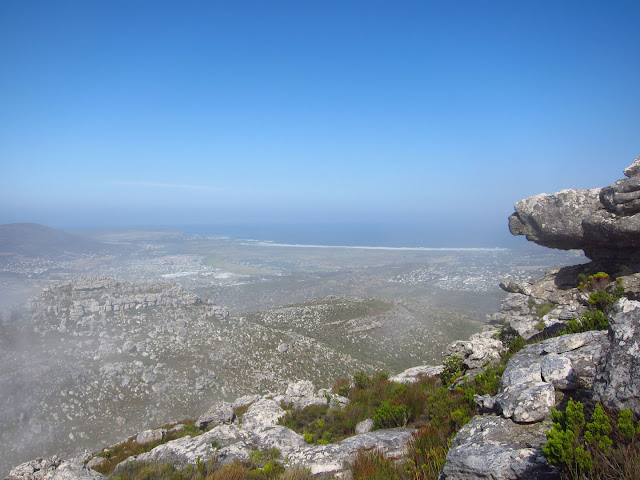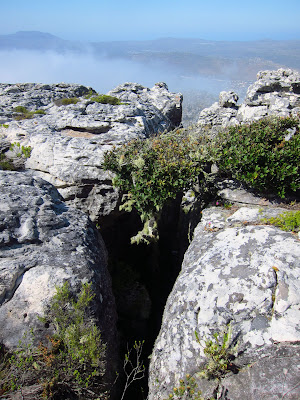I walked back into the mountains on the east side of Silvermine yesterday with Lyn McCallum and her friends Jenny and Andrea. I had imagined following a similar route to the one I took with Helen ten days ago, but this time I saw a new side of the peninsula, yet again. The hills within hills, valleys upon mountains, will never cease to impress me.
Happily, some cloud was blowing over the mountain from False Bay again. It would put us in a misty world many degrees cooler than the sweltering city below. I had espresso in my new flask (about to be returned to Cape Union Mart, another dud) and two raisin buns for breakfast, plus the necessary water.
Above, sticky-flowered Erica urna-viridis.
We started in early morning sunlight, climbing gently amongst the soft-eared Leucadendron bushes.
The distinctive petals of Pelargonium myrrifolium.
A mystery solved. I have been confusing Pelargonium longifolium and P. pinnatum (the latter above and below). I had looked to the flowers for the distinction, but obviously the key is the leaf. Pinnate leaves = pinnatum. Longifolium rarely has leaves this time of year.
Just as the eastern sun was beginning to be a bother to this hatless person (I hate hats), the mist met us head on. Phew.
We walked through a valley swept by a fire and found blackened Leucadendrons and a wonderful pioneer mix of flowers. Here are Watsonia tabularis and Aristea macrocarpa, both typical of this time of year, though the Aristea blooms earlier...
Everywhere we found pretty little Roella triflora, especially where larger growth had yet to appear after the fire. This clump grew in the middle of the path.
The three ladies screeched to a halt here: Toothbrush fern! they announced. I had never seen it before. Schizaea pectinata.
The little Aristea africana were everywhere, again.
All these plants grow in what appears to be pure sand. It is weathered quarzite and very acidic, for the most part. Plant your fynbos garden in lush compost and it may keel over dead.
More fire, more new growth. Fynbos needs fire. Just not too often. Cape Town now has a cigarette butt hotline to rat on anyone who tosses their burning butts out of moving cars or into any wild areas.
We started to climb to our first water stop and headed for some gorgeous rock formations.
Tiny hairs on this Leucaspermum caught the minsicule water droplets in the mist. The water accumulates until it runs down the stems to the ground, to provide essential summer moisture in this winter rainfall region.
Bertie's Balcony ahead. A perfect hide out and shelter, probably used by humans for millennia.
The view from beneath the rock overhang.
The weathered rocks are home to lichens and moss, and the moss provides footholds for wind dispersed seed.
A "buchu" - is it an Agathosma? Highly, penetratingly fragrant leaves. I am going to start experimenting in the kitchen.
We cleared the top of our low peak and could now see right over to the southern side of the peninsula.
Erica cerinthoides, thickly furred.
Erica mammosa, the white version.
Hm. Help?
A deep fuchsia Erica abietina subsp. atrorosea. I love it (Thanks to Tony Rebelo on iSpot for the subspecies).
By now, the mist was chasing us.
We turned our backs on it and explored some deep crevasses and a tree famous for its situation at the bottom of one. The sand in which it was rooted was damp from run off.
Here is the tree from above, where it emerges in the light.
Viewed from the other side, it lies flat in the direction of the prevailing wind and is festooned with lichen.
We headed for our breakfast point. I was starving. Perennially lagging behind with my camera I had been doing a lot of trotting to keep up. My gym-stressed Achilles tendons protested.
Below, you can see Table Mountain and Devil's Peak to its right in the distance.
Our view to the left, with Noordhoek and Long Beach in the middle, Chapman's Peak to the right..
Our view straight ahead, with Ou Kaapse Weg winding through it - the quickest route from the city to the southern parts of the peninsula.
And to the right, the way we had come.
After breakfast we turned and headed back down.
Agapanthus africanus, small and perfect. Still unaffected by the terrible agapanthus borer wreaking havoc on garden cultivars down below.
Watsonia tabularis. They are so frequent you are in danger of no longer noticing them.
Night-scented Struthiola ciliata (I'm beginning to have doubts about this one too. Could it be striata?).
A footpath garden of Mesembryanthemums and Aristea.
Not good with vygie (common name) ID's.
Roella ciliata, a larger version of the R. triflora we saw earlier.
Beautiful mounds of Serruria villosa started to appear in the next valley.
Someone suggested that this is a Rhus, but the leaves look wrong. Ideas? The berries were pleasantly tart, like tamarind. I tasted then spat, in a ladylike, delicate yet accurate manner, giving offence to no one.
The pretty but numerous and inbred family Fabacaea. Aspalanthus somethingorotherus.
A big black bee on the fragrant Agathosma we saw on our previous hike.
Still heading down, and more Leucaspermum bushes appeared.
Lachnaea grandifora.
Olea capensis, with a deliciously sweet scent.
Ornithogalum fragrans.
Tall Roella amplexicaulis.
Gardens of slender Hermas villosa and Watsonia tabularis.
Below: Men! We passed two groups of tanned and leathery hikers. The first lot asked, Are you perhaps the Fynbos Fillies?
We were not. But Andrea thought we might be the Meandering Mares.
A lingering pincushion flower on the Leucaspermum.
Protea nitida.
And the answer to the strange, empty, willowy stalks I have often seen rising a meter above the rest of the fynbos: Othonna quinqedentata.
Back on the boring jeep track, the final stretch, down which we hurried as fast as possible to get it over with, we passed flat mats of Carpobrotus edulis, the sour figs. A Cape delicacy often sold in piles at the side of the road. I tasted this one. Gah! Salty sticky stuff. It is frequently made into jam. Jenny, however, taught me to eat it the right way. About which more later.
And then I headed home again. Out of the mist, and back into the sweltering flatlands.




























































Wow, what a hike! And stunning pictures!
ReplyDeleteBertie's Balcony, have we been there, it looks familiar...
A good aerial view of Ou Kaapse Weg, my legs still remember the humiliation of following your dad up there on a bike...
Sigh.
woweee Marie! Thanks for letting us tag along this hike! Your photos are gorgeous--the smoke from the fires must have been strange but did make for lovely photos.
ReplyDeleteIn love with the aristea africana and the serruria villosas. will have to get some new names for those if you know what I mean, they might need some watercolor treatment.
In the meantime, will keep living vicariosly through your beautiful log of your trip.
Can't remember if you have a new camera or a new lens, but boy are you putting it to great use. Wonderful pictures. Hike on!
ReplyDeleteBeence, thank you, dearest husband :) And no, you've never been there (me neither, till yesterday).
ReplyDeleteBonbon, not smoke, mist! :-)
webb - Thank you! But it was just the little Canon SD95.
The second wonderfully photographed, comprehensively narrated in the 'Actually, South Africa IS a Garden' series.
ReplyDeleteThere seems to be an absolute refusal for anything not to thrive, just ask the crevice tree.
Magnificent walk! Fabulous in so many ways. The plants that struggle up through crevices and thrive in harsh climates are my favourites. God's bonsai gardens. When are you organizing the group tour???
ReplyDeleteLovely botanical tour, Marie. Some of your wildflowers I've seen before - in the glasshouse at KEW!
ReplyDeletePfffff, re-visited from a full screen computer. Wow. The legs still shiver. The heart still goes wild. The camera in its closed bag now begs to be let out. "Let me be like my little sister!" it says. Warning! In-fe-rio-ri-ty complex! ;-)
ReplyDeleteSuch beautiful photos, Marie, and some very interesting flower-info. That tall spindly yellow daisy is just one of several it's good to have a name for now, thank you! I've been exploring Silvermine for many years and *still* there are so many places I've not seen, valley's not yet explored. Makes my feet itch to go do more exploring!
ReplyDeletePS I hope your heel is healing nicely.
Absolutely beautiful, Marie! Having seen your photos over the past few years makes me feel as if I am sort of going home each time you return. I guess living vicariously isn't so bad. Thanks so much for sharing.
ReplyDeleteKeli'i
Love reading your blog and was fascinated by all the different plants you saw on your hike. Beautiful photos!
ReplyDeletespectacular pictures! thank you! I have never been to that part of the world, but I have a sense of it from your photos and writing.
ReplyDelete